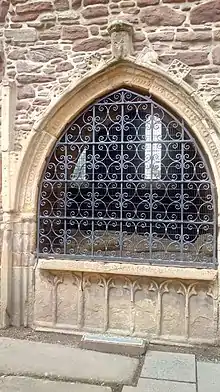Fairburn Tower
Fairburn Tower is a ruined Scottish castle near Inverness and the Muir of Ord in the parish of Urray.
.jpg.webp)
The tower house on a hill above the River Orrin is believed to have been built in 1545 for Murdo Mackenzie. He was a son of Roderick (Rory) Mackenzie,[1] and probably a nephew of John Mackenzie of Kintail.[2] Rory Mackenzie, who died in 1533, owned nearby farms or townships at Comrie,[3] Scatnell, and "Acheleis", and the mill at Contin.[4]
Murdo Mackenzie was a courtier, a groom or valet of the bedchamber for James V of Scotland from 1538.[5] Mackenzie is recorded as a companion of the king in 1540 at Stirling Castle, Falkland Palace, and Dudhope Castle. On 30 April 1540 the king's pursemaster John Tennent gave him 22 shillings to buy gunpowder in Dundee for the king's handguns.[6] Mackenzie, and three other grooms of the chamber, Alexander Kemp, Sandy Whitelaw, and Andrew Drummond, were given money for livery clothes in 1540, and their clothing allowance was increased.[7] In June 1542 Mackenzie was given a gift of "composition" worth £113.[8]
Murdo Mackenzie was granted the lands of Fairburn and other farms on 1 April 1542, and for the hearth of each homestead he was to pay the feudal duty of a hen, called a "reik hen." He was instructed to build a new house with orchards and a garden.[9] After he married Mariobelle Urquhart, in 1549 Mary, Queen of Scots gave him more land in the parish.[10] A translation of Mackenzie's charter is given in the Origines Parochiales.[11]

A wing with a stair was added to the older tower in the 17th-century. There are shot-holes or gun-loops at basement level and bartizans or turrets on wall heads.[12]
The adjacent lands of "Wester Fairburn" were given to Andrew Keith, Lord Dingwall in March 1584.[13]
The tower and the Mackenzie family were mentioned in the prophecies of the Brahan Seer, predicting the end of the family and the ruin of the building, and the apparition of a cow upstairs.[14] The seer, Kenneth Ower or Coinneach Odhar, was executed for witchcraft at the Chanonry of Ross in 1578.[15]
The tower was abandoned around the year 1780 and the roof, which was made with oak shingles, blew down in a gale in 1803.[16] Hugh Miller, who heard stories of the Mackenzies from a woman called Isobel, known as "Mad Bell", described the ruin as a "ghastly spectre of the past".[17]
Fairburn Tower is Category A listed by Historic Environment Scotland.[18][19]
References
- James Balfour Paul & John Maitland Thomson, Register Great Seal of Scotland: 1513-1546 (Edinburgh, 1883), p. 445 no. 1987
- James Balfour Paul, Accounts of the Lord High Treasurer of Scotland, vol. 7 (Edinburgh, 1907), p. xxxvi.
- MHG24725 - Township - Comrie
- James Balfour Paul & John Maitland Thomson, Register Great Seal of Scotland: 1513-1546 (Edinburgh, 1883), p. 159 no. 731
- Andrea Thomas, Princelie Majestie: The Court of James V of Scotland, 1528-1542 (John Donald: Edinburgh, 2005), p. 227.
- Athol Murray, 'Pursemaster's Accounts', Miscellany of the Scottish History Society X (Edinburgh, 1965), pp. 40, 44, 46.
- James Balfour Paul, Accounts of the Treasurer of Scotland, vol. 7 (Edinburgh, 1907), pp. 332-3.
- Accounts of the Treasurer, vol. 8 (Edinburgh, 1908), p. 85.
- James Balfour Paul & John Maitland Thomson, Register Great Seal of Scotland: 1513-1546 (Edinburgh, 1883), p. 606 no. 2632
- John Maitland Thomson, Register of the Great Seal: 1546-1580 (Edinburgh, 1886), pp. 66-7 no. 280
- 'Urray', Origines Parochiales Scotiae, 2:2 (Edinburgh, 1855), p. 520
- David MacGibbon and Thomas Ross, Castellated and Domestic Architecture of Scotland, vol. 3 (Edinburgh, 1889), pp. 462-5
- Gordon Donaldson, Register of the Privy Seal: 1581-84, vol. 8 (Edinburgh, 1982), p. 320 no. 1901.
- Alexander Mackenzie, The prophecies of the Brahan seer: Coinneach Odhar Fiosaiche (Inverness, 1882), pp. 29, 50-1
- Lizanne Henderson, '"Detestable slaves of the devil": Changing ideas about witchcraft in sixteenth-century Scotland', Edward J. Cowan & Lizanne Henderson, A History of Everyday Life in Medieval Scotland, 1000 to 1600 (Edinburgh, 2011), p. 241.
- Alexander Smith Mather, The County of Ross and Cromarty (SAP: Edinburgh, 1987), p. 81.
- Hugh Miller, An Autobiography: My Schools and Schoolmasters; Or, The Story of My Education (New York, 1855), pp. 169, 188, 241-2.
- Fairburn Tower, MHG7784
- Fairburn Tower HES LB14030